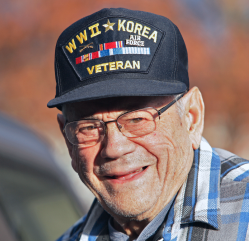Mesothelioma is a cancer caused by asbestos that forms in the lining of the lungs, abdomen, heart, or testicles. Around 1 in 3 mesothelioma patients are U.S. veterans, and many were exposed to asbestos while serving in the military. The Mesothelioma Veterans Center helps veterans with mesothelioma access VA benefits, treatments, and compensation.
What Is Mesothelioma?
Malignant mesothelioma cancer affects the mesothelium, the thin layer of tissue that covers internal organs. You can develop mesothelioma decades after exposure to a toxic material called asbestos.
If you’re a U.S. veteran who served before the early 1980s, you’re at a high risk of mesothelioma. All military branches used asbestos in bases, ships, and vehicles before the dangers were publicly known, meaning exposure was likely.
Quick Facts About Mesothelioma Cancer
- About 1,000 veterans develop mesothelioma each year.
- Mesothelioma forms 10-50 years or more after asbestos exposure.
- Pleural mesothelioma is the most common, affecting the lining of the lungs and making up more than 7 out of 10 cases.
- The 5-year survival rate is 15%, but some mesothelioma patients have lived nearly 30 years with treatment.
- Mesothelioma cancer treatments include surgery, chemotherapy, radiation, and immunotherapy.
- Veterans with mesothelioma can get treatment at a lower cost through the U.S. Department of Veterans Affairs (VA).
The Mesothelioma Veterans Center can help eligible veterans and loved ones get VA benefits, including monthly payouts, free or cheaper health care, and more. We can also assist with finding the right treatment plan and seeking compensation for any expenses.
Get our Free Veterans Packet to see how we can assist you or someone you love after a mesothelioma diagnosis.
What Is Mesothelioma Caused By?
You only develop mesothelioma after asbestos exposure — there is no other cause. Asbestos is a fiber-like material once used in thousands of products like insulation, wires, and cables.
Here’s how asbestos causes mesothelioma cancer:
- When asbestos-containing products are handled or damaged, fibers can be released into the air.
- You could breathe in or swallow asbestos fibers, which can get stuck inside your body and cause irritation.
- You can develop malignant mesothelioma cancer 10-50 years or more after first exposure.
You likely didn’t know asbestos was dangerous. Manufacturers of asbestos-containing products hid the health risks for decades. Anyone who comes in contact with asbestos could develop mesothelioma, though more exposure increases the odds of getting sick.
Why Veterans Are at Risk of Mesothelioma Cancer
If you served in the U.S. military before the early 1980s, you may have had regular or even daily exposure to asbestos. The military used asbestos to keep its bases, ships, and vehicles more durable. Veterans from every branch have gone on to develop mesothelioma later in life.
Here’s how veterans from each branch were put at risk of mesothelioma:
- U.S. Air Force: If you served in the Air Force, you could have been exposed to asbestos-containing plane products like brakes, engine liners, and heat shields.
- U.S. Army: You could have been exposed to asbestos in Army bases, barracks, and vehicles.
- U.S. Coast Guard: Thousands of Coast Guard ships were built with asbestos products for fireproofing and insulation. If you served on any of them, you could be in danger of mesothelioma today.
- U.S. Marine Corps: You may have been stationed on bases or ships that contained asbestos during your time in the Marines.
- U.S. Navy: There have been more mesothelioma cancer cases among Navy veterans than those of the other branches. All U.S. Navy ships used asbestos due to government mandates. You were also in danger of exposure if you served as a Navy shipyard worker.


“Asbestos didn’t kill anybody on the spot, that’s for sure. It took years later. That’s when it started catching up with us.”
— Walter Twidwell, U.S. Navy veteran with mesothelioma
U.S. veterans may have also been exposed to asbestos outside of the service in civilian industries like construction, shipbuilding, and plumbing. This increased their risk of getting mesothelioma later in life.
It wasn’t just veterans themselves who were at risk of mesothelioma. Their loved ones could develop mesothelioma from secondhand asbestos exposure, which happened when service members came home with asbestos dust stuck to their clothing or skin.
Types of Malignant Mesothelioma
There are four types of mesothelioma and you could develop any of them after asbestos exposure. The type depends on where cancer tumors form in your body. Learn about each mesothelioma type below.
Pleural Mesothelioma
Malignant pleural mesothelioma develops in the lining of the lungs (pleura). It’s the most common type, making up more than 75% of cases according to the American Cancer Society (ACS).
Symptoms include shortness of breath and fluid in the lung lining (pleural effusion). Patients typically live for 12-21 months, but you could live longer if diagnosed and treated promptly.
Peritoneal Mesothelioma
Peritoneal mesothelioma is the second-most common type of this cancer, accounting for 10-15% of cases. It forms in the abdominal lining (peritoneum). Symptoms include abdominal pain, swelling, and appetite loss.
If you have peritoneal mesothelioma, you may have a better health outlook. Patients live for nearly 4 and a half years on average when treated with surgery and chemotherapy, according to Cancer Management and Research.
Pericardial Mesothelioma
Pericardial mesothelioma forms in the heart lining (pericardium). It’s very rare, making up fewer than 1% of all mesothelioma cases. Symptoms include chest pain and irregular heartbeat.
The average life expectancy for pericardial mesothelioma is 2-6 months, but it may be possible for you to live longer with the right treatment plan.
Testicular Mesothelioma
Testicular mesothelioma develops in the lining of the testicles (tunica vaginalis). It is the rarest of all types, with fewer than 300 cases reported. Symptoms include pain and swelling of the testicle lining.
This type of mesothelioma cancer is highly treatable thanks to options like surgery. The life expectancy for testicular mesothelioma is nearly 4 years, according to Environmental Health. Around one-third of testicular mesothelioma patients live for 10 years or more, as noted by Urology.
Mesothelioma Symptoms
Mesothelioma cancer symptoms are mild at first but worsen over time. They’re often mistaken for less serious illnesses like the flu.
Common symptoms of mesothelioma include:
- Abdominal, chest, rib, shoulder, or upper back pain
- Fatigue
- Fever and night sweats
- Frequent, dry, or painful coughing
- Pleural effusion
- Shortness of breath
- Unexplained weight loss
- Weakness
Symptoms of mesothelioma can vary by type. Bloating is often the first symptom of peritoneal mesothelioma, while the first symptom of pleural mesothelioma is typically pleural effusion.
See a doctor if you were ever exposed to asbestos and now have possible mesothelioma symptoms. This is the first step to getting the treatments you need to live longer and to manage your symptoms.
Mesothelioma Diagnosis
If you’re worried that you have mesothelioma, you’ll need to see a doctor to get a diagnosis. Cancer doctors (oncologists) can recommend different options to help diagnose you.
Diagnosing mesothelioma typically follows a series of steps:
- A basic exam to discuss symptoms and any history of asbestos exposure
- Imaging scans such as CTs, MRIs, PETs, and X-rays to check for signs of tumors
- A biopsy to remove fluid or tissue samples to test for mesothelioma cells
A biopsy is the only way to confirm a diagnosis of mesothelioma. Once doctors are sure that you have mesothelioma, they can recommend a treatment plan that can allow you to live as long as possible.


I think it's really important at the time of diagnosis to give patients as much information as possible. I think that helps. They should understand that there are a lot of different treatment options available.
— Dr. Logan Roof, mesothelioma specialist
Mesothelioma Cell Types
During a diagnosis, mesothelioma doctors can determine which types of cancerous cells make up your tumors. Mesothelioma cell type greatly affects your overall health outlook as some types are easier to treat than others.
There are three main mesothelioma cell types:
- Epithelioid mesothelioma:This is the most common cell type and most easily treated. Epithelial mesothelioma cells stick together so they don’t spread as quickly.
- Sarcomatoid mesothelioma:This is the rarest and most aggressive mesothelioma cell type. These long, spindle-chaped cells spread faster through the body and don’t respond as well to treatments.
- Biphasic mesothelioma:This is when your cancer has both epithelioid and sarcomatoid mesothelioma cells. You will have a better outlook if there are more epithelial cells.
You may be able to get treatments for any mesothelioma cell type to potentially live longer by working with specialists. Learn more in our Free Veterans Packet.
Stages of Mesothelioma
Doctors can tell you which stage your mesothelioma cancer is in at the time of diagnosis. A lower mesothelioma stage means that the cancer hasn’t spread very far, so it will be easier to treat and you may have more time to live.
Stages of pleural mesothelioma cancer include:
- Stage 1 mesothelioma: This stage is contained in the lining of the lung and chest wall. Patients in this stage live the longest since many treatment options are available.
- Stage 2 mesothelioma: The cancer has reached the diaphragm (muscle that helps with breathing), a lung, or nearby lymph nodes. Doctors can still effectively treat many patients at this stage.
- Stage 3 mesothelioma: Tumors reach the lung lining, chest wall, more lymph nodes, or heart lining. It’s not as easy to treat as early stages, but long-term survival could still be possible.
- Stage 4 mesothelioma: Cancer has spread through the body, reaching the brain, liver, or bones. This is the hardest stage of mesothelioma to treat..
Pleural mesothelioma is the only type of this cancer with four distinct stages under the Tumor, Node, and Metastasis (TNM) system. Other types of mesothelioma are staged as either "localized" or "advanced."
Treatments can still potentially help you even if you have late-stage mesothelioma. John Stahl has lived for over 6 years with stage 4 mesothelioma thanks to treatments like chemotherapy. “His positive attitude has kept him going, and I think it helps his health too,” his wife says.
Mesothelioma Prognosis
Prognosis is your expected health outlook after being diagnosed. The average mesothelioma prognosis is often unfavorable, with most patients living for less than 5 years, but many patients have defied the odds and survived for long periods of time.
Your doctors use life expectancy and survival rate to measure your mesothelioma cancer prognosis. Learn about each below.
Mesothelioma Life Expectancy
Life expectancy is how long someone is expected to live after a diagnosis. The average mesothelioma life expectancy is 15 months with treatment, but you could potentially live for years with the right medical care.
Survival Rates for Mesothelioma
Survival rate is the percentage of people still alive a set amount of time after a diagnosis. The 5-year mesothelioma survival rate is 15%, according to the American Cancer Society.
Remember that survival rates and life expectancies are only estimates. Everyone’s cancer journey is unique, and you could live longer than expected.
Mesothelioma Doctors
One of the best ways veterans can improve their prognosis is to work with mesothelioma doctors who specialize in treating this cancer. Find top mesothelioma doctors in the VA health care network below.
Top mesothelioma doctors for veterans include:


Dr. Robert Cameron
Dr. Robert Cameron has nearly 30 years of experience treating pleural mesothelioma and works at the West Los Angeles VA Medical Center.


Dr. Daniel Wiener
Dr. Wiener treats pleural mesothelioma at the VA Boston Healthcare System and leads a team of cancer doctors to help veterans.


Dr. Eugene Choi
Dr. Choi treats veterans with peritoneal mesothelioma at the Michael E. DeBakey VA Medical Center in Houston.


Dr. Lorraine Cornwell
Dr. Cornwell treats pleural mesothelioma at the Michael E. DeBakey VA and has over 20 years of experience.
These doctors work at top mesothelioma cancer centers located across the country and can provide the highest level of care to veterans and civilians.
Mesothelioma Treatment Options
There are mesothelioma treatments that you could access to improve your survival and ease symptoms. Which treatments your doctor recommends will vary based on your cancer’s stage, your overall health, and other factors.
Top treatments for mesothelioma include:
- Surgery: Doctors remove tumors and organs that mesothelioma has spread to.
- Chemotherapy: This is medication used to shrink tumors and destroy mesothelioma cells.
- Immunotherapy: The immune system is trained to better find and destroy mesothelioma cells in hiding.
- Radiation: This kills mesothelioma cells using X-rays and other high-energy particles.
- Palliative care: Any type of treatment used to relieve pain, like minor surgeries and medications to manage symptoms.
- Clinical trials: New treatments or versions of treatments are tested to see how they can help mesothelioma patients.
Doctors typically use several mesothelioma treatments together to destroy as much of the cancer as possible, giving veterans and civilians a better chance of living longer.


“If you're in my clinic, you're going to see survivors who have been around for over a decade. You just have to make sure you're selecting patients appropriately, and that the treatment that you're giving them is not something that's going to hurt their survival or their quality of life.”
— Dr. Raja Flores, mesothelioma specialist
VA Benefits and Compensation for Mesothelioma Veterans
If you’re a veteran with mesothelioma, you may qualify for a wide range of medical and financial benefits offered by the VA. You may also be able to pursue additional compensation separate from VA benefits.
Here’s what to know about:
- Mesothelioma VA benefits: Notable VA benefits include disability payouts worth $4,044.91 a month and free or inexpensive treatment through VA health care. We can help you file for or increase your mesothelioma VA benefits.
- Mesothelioma lawsuits: Mesothelioma lawsuits award $1 million or more on average. Most lawsuits end in out-of-court mesothelioma settlements, providing quicker access to compensation. The U.S. military and government are never sued.
- Asbestos trust funds: An estimated $30 billion is available in mesothelioma trust funds as of 2025. You may qualify to access some of this money, and you won’t need to go to court to receive it.
Our team can pursue mesothelioma VA benefits and compensation on your behalf, if eligible. Get a Free Veterans Packet to explore all the resources available to you.
Help for Veterans With Mesothelioma


A mesothelioma diagnosis can bring a lot of uncertainty to you and your family, but it’s possible to still live a fulfilling life after a diagnosis. Treatment can potentially give you more time with the people you love, and there are resources you can access to ease any financial worries.
The Mesothelioma Veterans Center stands ready to support veterans and their families following a mesothelioma diagnosis.
Our team of U.S. veterans, nurses, and patient advocates can:
- Connect you with top doctors and treatments
- Help you file for or increase your VA benefits
- Pursue compensation often worth $1 million+
- Offer other support options after a cancer diagnosis
U.S. veterans like you proudly and bravely served our country. After a mesothelioma diagnosis, let us serve you.
Get a Free Veterans Packet or call (877) 450-8973 now to find out how we can assist you or someone you love.
Mesothelioma Cancer FAQs
Why are U.S. veterans at risk of mesothelioma?
Veterans are at risk of mesothelioma since the U.S. military relied on asbestos from the 1930s to the early 1980s and the dangers were hidden by manufacturers. Service members thought asbestos was a safe way to keep ships and bases durable.
Any veteran exposed to asbestos could develop mesothelioma later in life. Those at the highest risk served on Navy ships, worked in shipyards, or handled asbestos products daily as part of their military job duties.
What is the life expectancy with mesothelioma?
The average life expectancy for mesothelioma is 15 months. However, some patients have become long-term survivors, living for nearly 30 years.
You have a better chance of living longer with mesothelioma if you’re diagnosed before the cancer spreads, because you’ll have more treatment options available.
Contact us now for help finding top mesothelioma treatments and affording medical expenses following a diagnosis.
What are 5 signs and symptoms of mesothelioma?
A cough, shortness of breath, chest pain, fatigue, and weight loss are 5 common symptoms of mesothelioma cancer. The symptoms are mild at first but worsen as time goes on and the cancer spreads.
Mesothelioma symptoms like these tend to appear 10-50 years or more following asbestos exposure. If you were ever exposed to asbestos and now have any of these symptoms, see a doctor and discuss your concerns with them.
What stage of mesothelioma is death?
Stage 4 mesothelioma is typically considered the deadliest stage. By this point, the cancer has spread through the body and is hard to treat.
That said, it’s possible to live a long time with stage 4 mesothelioma. For example, John Stahl is still alive over 6 years after his stage 4 diagnosis and says he’s “pretty well back to normal.”
Is mesothelioma curable?
There isn’t a cure for mesothelioma yet. However, some patients have lived for many years or even decades after their diagnosis thanks to different treatments.
“I hesitate a little bit to use the term cure in the context of mesothelioma, because I think that it's something that's actually very difficult to define,” says mesothelioma specialist Dr. Adam Bograd. “But, we do have long-term survivors. Some patients are still alive 10, 12, even 15 years out after treatments like surgery.”
For example, Mary Jane Williams achieved mesothelioma remission, living cancer-free for 15 years thanks to treatments. She passed away without the cancer ever returning.
What is the longest-living person with mesothelioma?
The longest-living mesothelioma survivor is Sissy Hoffman. Diagnosed in 1996 with pleural mesothelioma, she lived for nearly 30 years with treatment. Paul Kraus is the longest peritoneal mesothelioma survivor, living for 27 years before his passing in 2024.
U.S. Army and Air Force veteran Art Putt is a long-living veteran with mesothelioma. After his diagnosis in 2018, treatments and diet changes slowed his cancer and he’s still thriving today.
Get a Free Veterans Packet to find resources that could help you live longer with mesothelioma.
What is the age range for mesothelioma?
The average mesothelioma patient is 72 years old, according to the American Cancer Society. This is because it takes 10-50 years for mesothelioma tumors to develop after asbestos exposure. That said, people of any age can develop this cancer if they were exposed.
Has anyone ever survived mesothelioma?
Yes, some people have become long-term mesothelioma survivors. The longest have lived for close to 30 years after being diagnosed.
You have a better chance of living longer if you get promptly diagnosed and treated. Call (877) 450-8973 for help finding medical care that may help you live longer.
The Mesothelioma Veterans Center has no affiliation with and is not endorsed or sponsored by Dr. Robert B. Cameron. The contact information above is listed for informational purposes only. You have the right to contact Dr. Cameron directly.


